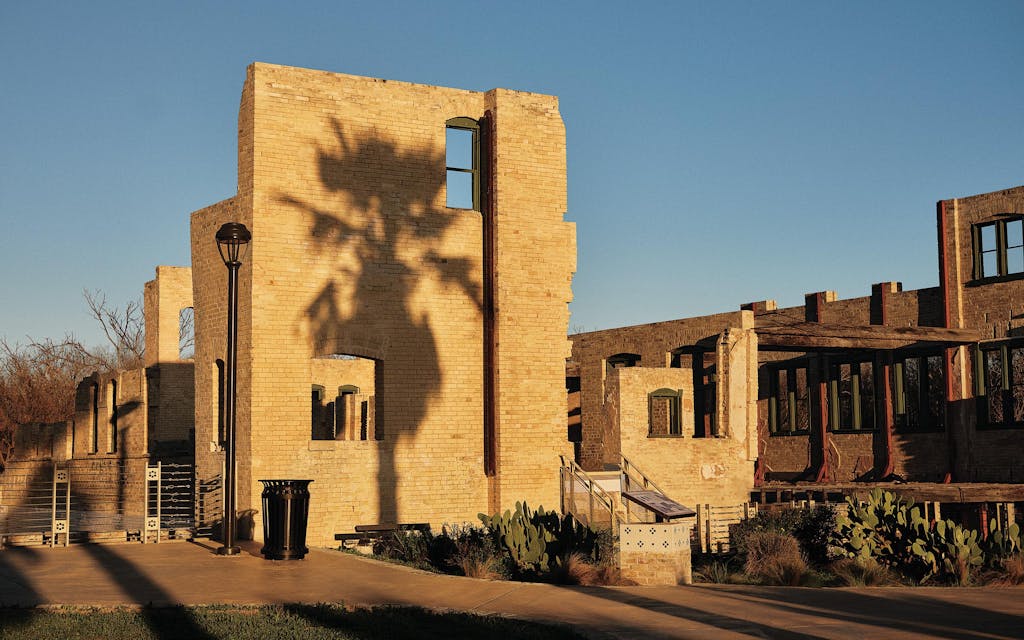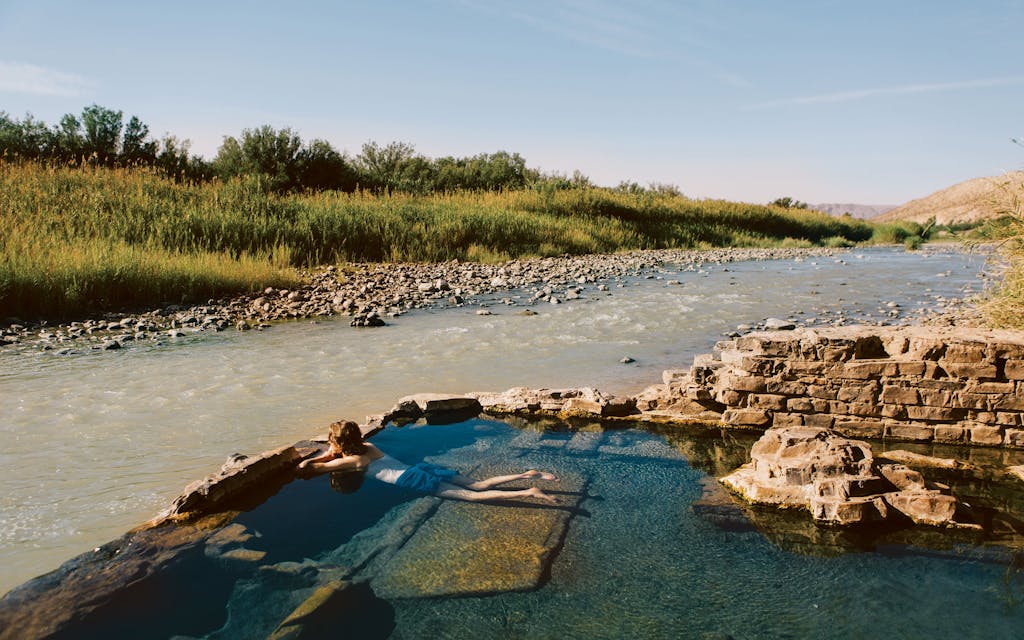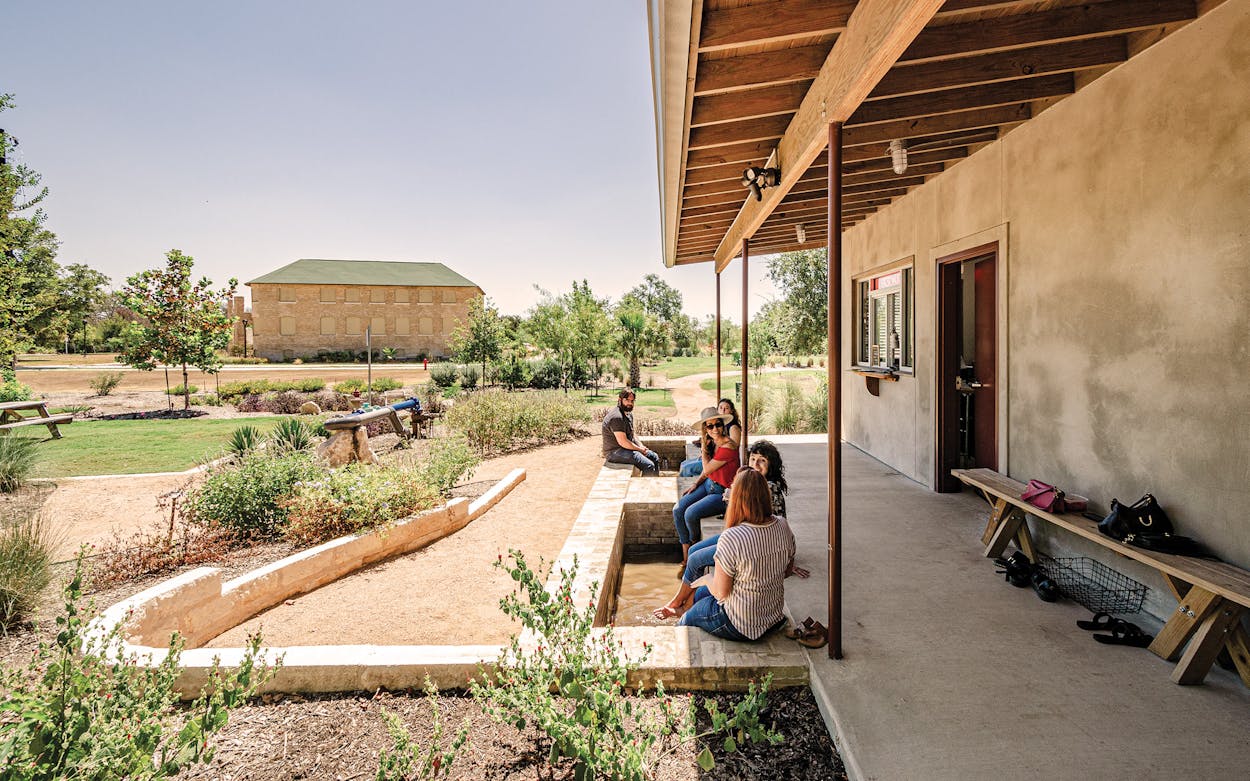The air had turned frigid thanks to an arctic front that had muscled its way down to San Antonio, but steaming hot water beckoned. My wife and I carefully climbed three icy wooden steps and then immersed ourselves in an outdoor cedar tub big enough for two. Submerged up to our necks, we spent the next hour soaking while we sipped wine and nibbled on charcuterie.
The tub was filled with water from an underground reservoir that has been soothing Texans for 135 years. These days it is being tapped by Camp Hot Wells, which opened last year next to the ruins of a resort that once attracted pilgrims from across the country.
When the Hot Wells Hotel opened, in 1901, guests could easily get there by taking an electric streetcar south from downtown San Antonio. The nearly six-mile trip was well worth the nickel fare (the equivalent of about $1.80 today). The resort’s bathhouse featured three pools—one each for ladies, gents, and the sick—where one could relax in around 104-degree sulfurous water, drawn from a well on the property and touted as a cure for an assortment of maladies. If this wasn’t enough of an enticement, visitors could stop by a nearby ostrich farm, where they could bet on ostrich races or buy a plume for one’s hat (then quite the fashion) for fifty cents.

Compared at the time to Europe’s famous hot spring spa in Karlsbad, Germany, the three-story hotel, with its elegant gabled roof, attracted a clientele ranging from the Cincinnati Reds, who held their training camp on the property, to Hollywood luminaries such as Charlie Chaplin and Cecil B. DeMille. The railroad magnate E. H. Harriman lived in a tent on the hotel grounds for a few weeks in February 1909, hoping the waters would restore his health. (The therapeutic benefits advertised included relief from herpes, sciatica, and a type of tuberculosis known as the king’s evil.) A local newspaper proclaimed Harriman’s condition much improved after his stay, but he died later that year.
The hotel’s time in the spotlight was as fleeting as an ingenue’s career. The building burned down in 1925, and the property changed hands a few times over the following decades. At one point, it opened as a trailer park with a bar and grill called the Flame Room. That closed in 1977, and later plans to restore the site to its former glory fizzled. The end came when the bathhouse, too, was destroyed by fire, in 1988, although its ruins remained.
Camp Hot Wells feels more like a scaled-down hot spring resort crossbred with a San Antonio icehouse. There’s no hotel, but you can relax with a glass of beer or wine while taking the waters. In lieu of the long-gone streetcar, might I suggest a bike? From the King William Historic District, the property is an easy four-mile ride along the San Antonio River via an impeccably maintained route. Expect to see cormorants, egrets, and herons—but no ostriches.
It’s one of several historic Texas spas where the waters are flowing again. Several sites are being restored, modernized, and reopened. What are you waiting for? The water’s nice. Come on in.


Camp Hot Wells sits next to a Bexar County park, where the ruins of the century-old bathhouse have been stabilized and restored and are dramatically lit up at night like a San Antonio Parthenon. James Lifshutz, who also codeveloped the city’s Blue Star Arts Complex, purchased the property in 1999. He donated the ruins to the county, which turned it into the park twenty years later, and he drilled a new well and built a modern bathhouse, bar, and gardens. Camp Hot Wells opened in January 2023.
Lifshutz has become a bit of a hot spring connoisseur, having tested many around the world. But when asked if he thinks the waters have healing powers, he brushes it off. “I don’t know, and I don’t care. It feels good.” (While aquatic miracle cures have been overhyped in the past, the medical profession generally appreciates the value of hydrotherapy.)
The bathhouse ruins aren’t the only historic site in the area and are definitely not the oldest. On the other side of the river sits Mission San José, built in 1768 and the cornerstone of the string of missions that make up a UNESCO World Heritage Site. Cyclists can pedal along the mission trail and then cross a bridge to Camp Hot Wells for a postride soak.
The tubs draw from the same underground reservoir once used by the hotel. The water temperature varies daily but always surpasses 100 degrees. Guests can reserve one of two options for hourlong soaks in private garden suites: a dip in a two-person cedar tub or in side-by-side antique clawfoot tubs. The price, ranging from $75 to $100, includes towels and drinking water. You can order from a selection of craft beers, sake, and wine, and build your own charcuterie board. Don’t have a reservation? Sit on a brick bench and take off your shoes; the communal footbath is free as long as you patronize the bar.
During our hour in the cedar tub, my wife and I pretzeled ourselves so that only our heads were exposed to the freezing air. I expect we looked a little like those hot spring–loving snow monkeys in Japan. The water smelled of sulfur and was dark gray, the color of laden Texas thunderclouds. We began to relax in earnest. To expedite the unwinding we ordered a bottle of 2021 Müller-Thurgau orange wine from Austria and a plate of Manchego, Spanish chorizo, and pickled vegetables. Nearby the attendant lit a piñon log in a firepit. A plump sparrow alit on the wooden privacy fence, keeping a watchful eye on us.
Chalk it up to a postpandemic compulsion to treat ourselves, or maybe we’re just tapping more into a primal desire to float away our worries, but the choices for soaking in the state’s special waters are growing. Much like San Antonio’s Hot Wells, other dormant, historic spas are being reborn. Ottine Mineral Springs, about seventy miles east of San Antonio, is preparing to make a splash. It draws on the same source that once provided water to a facility for children with polio and others who struggled with injuries and range of motion. It reopened in 2020, but on an invitation-only basis, leaving most of us to gaze longingly at the occasional Instagram posts by guests offering tantalizing glimpses of steaming waters in two pools, sleek new showers, ivy-covered walls, and hammocks. General manager DeDe DeStefano told me that it will open to the public, with more amenities, later this year.

In Mineral Wells, about fifty miles west of Fort Worth, investors are harnessing the city’s namesake. The 1920s-vintage Crazy Water Hotel, which reopened in 2021, plans to unveil its spa, a place for visitors to soak in the mineralized (though tepid) water that flows from underneath the city, by the end of the year. “We will have a spa here come hell or high mineral water,” joked Cynthia Nelson, the hotel’s general manager. If you don’t want to wait for the hotel’s facility, the ten-year-old Crazy Water Bath House & Spa offers soaks in the water, which turns milky white because of all the tiny bubbles in it.
These modern-day aquapreneurs are part of a long Texas tradition. Consider the story of J. O. and Bessie Langford, early twentieth-century homesteaders along the Rio Grande. A burbling hot spring flowed from a rock ledge on their land, so J.O.’s first thought was to build a bathhouse. Bessie’s response, according to his memoir: “Shouldn’t we build a house to live in first?” They built both. From 1909 until 1942—except for a few years in the middle when border unrest forced its closure—visitors could enjoy the 105-degree water in cement-lined tubs at the Langfords’ bathhouse. Those soakers returned full of stories of the beauty of the region, which helped drum up interest in creating Big Bend National Park. You can still enjoy the waters in the ruins of the bathhouse.
The last great hot spring boom in Texas, more than a century ago, was fueled by travelers seeking cures that doctors couldn’t provide.
Today hot spring and mineral water baths are making a comeback for folks seeking a remedy for a more modern ailment: the stress caused by our nonstop, hyperconnected world.
“We live in a very fast-paced time and are very plugged in. Being in a very natural environment, in mineral water with health benefits—it’s an amazing reset,” said David Dronet, the managing partner of New Braunfels–based Olympus Real Estate Group. In 2018 he bought and started redeveloping the Springs Resort in Pagosa Springs, Colorado, a popular hotel and resort with 25 soaking pools that draw from the world’s deepest geothermal spring. He recently opened another hot spring resort, in Southern California.
I can personally attest to the therapeutic value of unplugging. While soaking at Camp Hot Wells, I reached for my phone to check something or other. The steam rising from the water made it hard to read. I put it down. Whatever it was could wait.

Gathering Steam
A guide to Texas’s hot springs and mineral water baths.
Big Bend Hot Springs: Located inside Big Bend National Park, down a two-mile gravel road, the hot spring (pictured) is free and open to the public. If the Rio Grande floods, however, the tub may be submerged.
Chinati Hot Springs: Billed as an oasis in the Chihuahuan Desert, this West Texas resort is far, far from the Marfa crowd—about a ninety-minute drive. The property offers seven adobe cabins, with plentiful
hiking options nearby.
Crazy Water Bath House & Spa: The boutique spa in Mineral Wells features three private tub rooms in which to enjoy the town’s famous mineral waters. It also offers hot-towel wraps and massages.
The Crazy Water Hotel (coming soon): The 62-room Mineral Wells hotel is building a spa to highlight the town’s famous mineral water in a setting that will combine modern amenities and a
classic soak.
Ottine Mineral Springs (coming soon): Located near Gonzales, seventy miles east of San Antonio, a former polio hospital is being redeveloped into a wellness spa featuring hot spring baths.
Sulphur Springs Camp: This family-owned facility in Bend, ninety miles northwest of Austin, boasts a spring-fed swimming pool of about 68-degree sulfurous water, along with cabins to rent.









